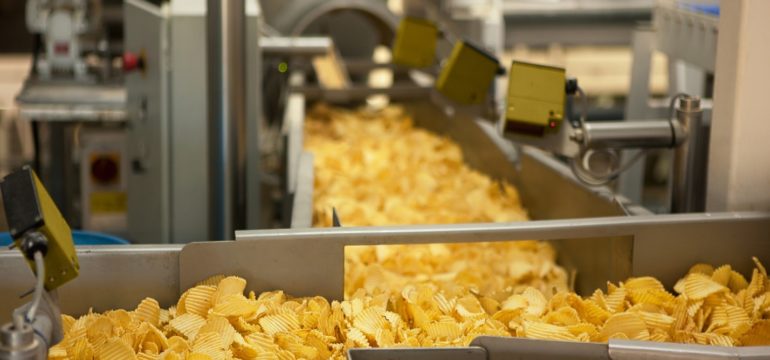By Bryan Quoc Le | 150 Food Science Questions Answered
The following is an opinion essay submitted to the 2018 AAAS Science & Human Rights Essay Competition.
The Origins of Modern Food Technology
The overreaching aims of the modern food industry can be generalized as extending the shelf-life of foods using preservation techniques, enhancing the palatability of foods, providing adequate nutrients, and generating profits for both the company and shareholders [1]. In order to reach these aims and evolve over time, much of the technology used by the food industry today was derived from innovative processes at the time. The food industry incorporated these into their own manufacturing processes in response to challenges that arose through the expansion of the modernized food industry throughout the 20th century. These challenges included reducing the presence of pathogens for safety, extending food stability for transportation, and enhancing the flavors and textures of foods for consumer enjoyment.
When food-borne pathogens were discovered to be the cause of life-threatening illnesses, driven by massive outbreaks in the early 1900s, food safety regulations were put into place by the USDA and FDA to ensure the food consumed by the public was deemed safe to eat. These widespread outbreaks included those of 1911 and 1922 caused by Streptococcus in raw milk, resulting in 70 deaths, an outbreak of botulism in 1919 from canned olives, and a massive outbreak of Typhi bacteria in 1924 caused by contaminated oysters [2]. New regulatory reforms required the food industry to develop methods to thermally process their food products, or include proper instructions to cook the food before consumption. The processing methods developed were largely based on the principles elaborated by Louis Pasteur developed in 1864 from investigating pasteurization processes to reduce pathogenic microbiological populations. These advances in thermal processing allowed companies to produce safe food products that could be canned or jarred, with expiration dates lasting for months or even years after production without spoilage.
Another challenge in addition to food safety that arose in the burgeoning food industry included the spoilage of food, which resulted in a high percentage of waste and lost resources. Refrigeration and freezing technologies were developed to help preserve food for long-term storage. And as refrigeration became more affordable to every household, the food industry began designing perishable food products that could be easily refrigerated for short-term consumption. However, refrigeration technology was still expensive, and many manufacturing and preservation processes were aimed at producing foods that could be readily stored for long periods of time without changes to product palatability or risking the growth of pathogens. These methods included the addition of chemical preservatives, disinfectants, antioxidants, and moisture-reducing ingredients to ensure extended shelf life.

Accessed from: https://www.hungryforever.com/fast-food-junk-food-street-food-understanding-differences/
The Rise of ‘Junk Foods’
These technologies discussed above became important for the transition of food production from small-scale food producers and companies, to international corporations. They gave manufacturers the power to mass produce large quantities of inexpensive food with long shelf lives, which could be produced, stored, transported, and distributed across nations with relative ease. Furthermore, flavor technologies became critical in producing palatable foods, as the thermal processing methods needed to maintain the safety of products all but destroyed their native flavors. For the average consumer, the driving force for demand was, and still is, taste, and so an entire flavor sub-industry was forged to provide food companies the technical expertise and ingredients needed to produce both appetizing foods and safe foods that could capture desirable markets. These flavors were produced either synthetically using the principles developed by organic chemists using the purified petrochemical by-products made available from the rapidly expanding petroleum industry of the early to mid-1900s or extracted as essentials from natural products at high cost [3].
With the simultaneous development of modern food ingredient and preservation technologies, new, better flavored products became accessible to the general consumer that did not require refrigeration. The low cost of sugar syrups made available through novel processes to enzymatically convert starches to simple sugars allowed manufacturers to add sugars to both improve the taste of foods and extend their shelf-life at room temperature. Salt, another flavor enhancer and food preserver newly harvested from industrialized salt-mining operations, was judiciously added to foods as well. Large-scale oil extraction methods and growth of oil crop cultivation gave way to an abundance of food oils that could be used to fry or be included in products to further enhance their flavor and texture. Also, grain flours became readily dehusked using automated equipment and bleached white with powerful chemical oxidizers for their visual appeal and product functionality. The dropping costs of raw materials derived from the state-of-the-art technologies of the time, transformed sugar, salt, and oil to become the primary ingredients used to produce a wide array of products to satisfy the growing consumer demand for low-cost, tasty foods in the Western world [4].
However, in time, many of these nutrient-poor products were found to have negative impacts on health when consumed in large quantities over many years. Medical practitioners and researchers began seeing a correlation between consumption of certain foods and the rise of lifestyle diseases, including obesity, cancer, diabetes, and cardiovascular conditions [5-8]. Along with other factors, these diseases rose to the top of the list as the most lethal diseases in the United States and continue to challenge the medical community. In response, health organizations and regulatory bodies have instituted a number of reforms in the past several decades to curb consumer eating of low-nutrient foods and promote consumption of healthier, fresher foods [9]. Ongoing efforts by these policy groups continue to affect changes that have impacted the food industry and consumer preference to this day.
United Nations and Junk Food Policy
In 2016, the U.N.’s independent expert and Special Rapporteur on the right to food Hilal Elver, advised that the widespread availability of junk food be considered a human rights concern and a modern form of malnutrition [10]. The low cost of highly preserved and flavor-enhanced foods has made these products globally available to every economic strata. According to Elver, the current situation has forced low income earners to choose between nutritious foods and economic viability, with nearly 2.1 billion people around the world being overweight or obese. As a potential solution, she has suggested that governments adopt a tax on foods deemed unhealthy for human consumption and convert tax funds into subsidies that reduce the cost of healthy food products, including fruits and vegetables. Other suggestions have included regulating marketing and advertising of unhealthy foods, as well as adoption of clear labeling practices that allow consumers to make more informed choices [11].

Accessed from: http://www.un.org/en/sections/documents/general-assembly-resolutions/
These types of recommendations have been scrutinized as over protection by the government and meddling with market forces [12, 13]. Implementation of taxes on food product exports is likely to alienate food companies and promote resentment towards regulatory bodies. These policy recommendations also ignore the efforts made by the food industry and partners to combat these nutritional challenges, and frames the food industry as a homogeneous group solely responsible for many of the issues arising from low-nutrient, high-calorie food consumption.
Moving Forward
The landscape of the food industry is already shifting as many established corporations have acquired smaller firms specializing in foods touted as natural, healthy, and organic to expand their product offerings in niche markets. And in the last decade, the global startup community has heavily invested in high-tech food ventures with mission statements framed by social and environmental welfare, creating a new wave of consumer-responsive companies relying on the advancing scientific fields of synthetic biology, tissue engineering, and proteomics to produce their products with lower environmental impact by bypassing traditional agricultural methods and food design. These companies include Impossible Foods, Memphis Meats, and Gingko Bioworks, among others. Other changes include the industry-wide adoption of “Clean Label” as a communication tool for consumers to signal for transparent formulation practices in products, such as the inclusion of little or no artificial ingredients. It’s clear that in our current Information Age, consumers can readily affect the marketplace by their purchasing choices and concerns, which suggests the food industry is currently quite malleable to consumer demand and interests.
Inevitably, food technology will continue to evolve, however, the direction that it takes will be strongly tied to the complex interplay of market forces. In a hypothetical dystopian world, it’s possible to see the technical development of hyperpalatable foods that could lead to extreme food addiction on a global scale [14]. On the other hand, the industry and field could also be directed towards the large-scale adoption and fine-tuning of non-thermal processing technologies that minimally affect the nutritional properties of a food product, such as high-pressure, pulsed electric field, and cold plasma processing, giving low-income earners the opportunity to purchase low cost, nutrient-rich fresh produce and produce-based foods with enhanced shelf-lives. These are simply examples of potential scenarios. While food scientists can be driven by an innate sense of curiosity to push the envelope of scientific knowledge and technology, the potential effects that their work should be strongly considered in the decision matrix for commercialization. The advancement of food technology has many possibilities that could directly impact the health of vulnerable populations either positively or negatively in the long term.
To make effective change, a concerted effort between the food industry, medical community, policy advisors, and regulatory bodies will be needed to move forward on the challenges of global health and nutrition. Self-regulation could be a potential solution to addressing these concerns [15]. Indeed, some food companies have become increasingly more transparent about the ingredients and production practices used to create modern foods. Creating a unified code of ethics sanctioned by food companies and technologists may be an important step in the future to garner and retain consumer trust, while reducing the negative health impacts of certain low-cost food products on populations of lower socioeconomic status. Regardless, the technology used to produce food has partially contributed to the situation we find ourselves today. And food technology and scientists will continue to play an important role in shaping the food landscape in relation to the worldwide challenges of health, diet, and malnutrition.
Want to keep up with the conversation? Follow us on Instagram and Facebook for quick updates on seminars, events, and food science!
References
-
Fellows, P. J. (2009). Food processing technology: principles and practice. Elsevier.
-
History of Food Poisoning in the United States. (n.d.). Retrieved April 02, 2018, from http://thefoodpoisoninglawyers.com/history-of-food-poisoning-in-the-united-states/
-
The Inexorable Rise Of Synthetic Flavor: A Pictorial History. (2015, November 23). Retrieved April 02, 2018, from https://www.popsci.com/history-flavors-us-pictorial
-
Smith, A. F. (2006). Encyclopedia of junk food and fast food. Greenwood Publishing Group.
-
Wiles, N. J., Northstone, K., Emmett, P., & Lewis, G. (2009). ‘Junk food’diet and childhood behavioural problems: results from the ALSPAC cohort. European Journal of Clinical Nutrition, 63(4), 491.
-
Bowman, S. A., & Vinyard, B. T. (2004). Fast food consumption of US adults: impact on energy and nutrient intakes and overweight status. Journal of the American College of Nutrition, 23(2), 163-168.
-
Fielding, J. E., & Simon, P. A. (2011). Food deserts or food swamps?: comment on “fast food restaurants and food stores”. Archives of Internal Medicine, 171(13), 1171-1172.
-
Lustig, R. H. (2017). Processed food—an experiment that failed. JAMA Pediatrics, 171(3), 212-214.
-
Boone-Heinonen, J., Gordon-Larsen, P., Kiefe, C. I., Shikany, J. M., Lewis, C. E., & Popkin, B. M. (2011). Fast food restaurants and food stores: longitudinal associations with diet in young to middle-aged adults: the CARDIA study. Archives of Internal Medicine, 171(13), 1162-1170.
-
Elver, H. (2016). Interim report of the Special Rapporteur on the right to food. A/71/282. UN General Assembly, Seventy-First Session, New York, NY, USA, 3 August 2016.
-
Ludwig, D. S., & Nestle, M. (2008). Can the food industry play a constructive role in the obesity epidemic?. JAMA, 300(15), 1808-1811.
-
Leonard, K. (2015, June 05). The Great Government Takeover. Retrieved April 03, 2018, from https://www.usnews.com/news/the-report/articles/2015/06/05/the-great-government-takeover-of-food
-
Souter, J. (2017, November 27). The Government Has Been Meddling in Food and Nutrition for a Long Time | Josh Souter. Retrieved April 03, 2018, from https://fee.org/articles/the-government-has-been-meddling-in-food-and-nutrition-for-a-long-time/
-
Dvorsky, G. (2014, May 12). How ‘Hyperpalatable’ Foods Could Turn You Into A Food Addict. Retrieved April 03, 2018, from https://io9.gizmodo.com/how-hyperpalatable-foods-could-turn-you-into-a-food-add-1575144399
-
Gunningham, N., & Rees, J. (1997). Industry self‐regulation: an institutional perspective. Law & Policy, 19(4), 363-414.

Bryan Quoc Le | 150 Food Science Questions Answered
IFTSA VP of Digital and Social Media (2019-2020)
Bryan is the author of 150 Food Science Questions Answered (Rockridge Press, 2020) and a Ph.D. candidate in Food Science at University of Wisconsin-Madison studying the health effects of garlic and onion flavors. He received his B.S. and M.S. in Chemistry at the University of California, Irvine. In another life, he walked 2,000 miles from California to Louisiana in six months, and learned that eating tuna and peanut butter every day was not meant for the average human body. After he met his wife, he learned that there was more to good food than canned goods and smoothies. While not juicing onions and pressing garlic, Bryan likes to run half-marathons, discover interesting cuisines with his wife, and help entrepreneurs develop great food products.






who’s the publisher??
idek bro lmaoooo